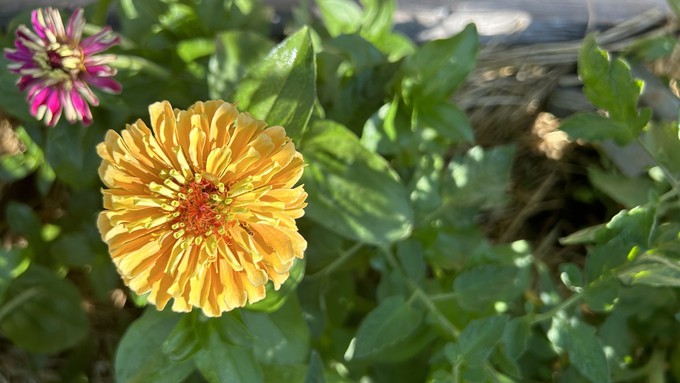
Red-hot start could make July challenging

A two-tone zinnia catches the early morning light. There's still time to plant zinnias and other flowers for summer color, but wait until it cools off a bit later in the week. Kathy Morrison
Stay hydrated. That advice applies both to plants and people as we’re on high heat alert through Sunday night.
According to the National Weather Service, Sacramento is in the midst of its first triple-digit heat wave of 2023. Downtown hit 104 degrees Friday and 107 is forecast Saturday. Some Sacramento area communities could see 110 degrees.
Last Sunday (June 25), Sacramento’s high was only 76 degrees. That’s a 30-degree jump.
June saved its hottest day for last. “At 1:30 p.m. today, downtown Sac hit 100ºF!! First time this year!” tweeted the NWS Sacramento office on Friday afternoon. “We just ended a 293-day streak of below 100 temps. This is the 2nd longest streak since 2000. HOT DOG!”
Fortunately, these triple-digit days won’t last. By Tuesday’s Fourth of July holiday, Sacramento’s forecast high is 94 degrees. Normal for July: 92.
Take advantage of cooler temperatures in the early morning to get things done. (Or wait until next weekend if possible.)
* Keep your vegetable garden watered, mulched and weeded. Water before 8 a.m. to reduce the chance of fungal infection and to conserve moisture.
* Don’t fertilize during a heat wave; wait a week before feeding hungry veggies.
* Don’t let tomatoes wilt or dry out completely. Give tomatoes a deep watering two to three times a week.
* Avoid blossom end rot by keeping fast-developing vegetables evenly watered.
* Harvest vegetables promptly to encourage plants to produce more. Squash especially tends to grow rapidly in hot weather. Keep an eye on zucchini.
* Expect a gap in tomato production; pollen tends to dry out when temperatures hit 95 degrees and fewer tomatoes will set.
* If your melons and squash aren't setting fruit, give the bees a hand. With a small, soft paintbrush, gather some pollen from male flowers, then brush it inside the female flowers, which have a tiny swelling at the base of their petals. (That's the embryo melon or squash.) Within days, that little swelling should start growing.
* Pinch back chrysanthemums for bushy plants and more flowers in September.
* Remove spent flowers from roses, daylilies and other bloomers as they finish flowering.
* Pinch off blooms from basil so the plant will grow more leaves.
* Later in the week, plant petunias, snapdragons, zinnias and marigolds for instant summer color.
* From seed, plant corn, pumpkins, radishes, winter squash and sunflowers. Keep seedlings evenly moist.
Comments
0 comments have been posted.Sacramento Digs Gardening to your inbox.
Sites We Like
Garden Checklist for week of July 21
Your garden needs you!
* Keep your vegetable garden watered, mulched and weeded. Water before 8 a.m. to reduce the chance of fungal infection and to conserve moisture.
* Feed vegetable plants bone meal, rock phosphate or other fertilizers high in phosphate to stimulate more blooms and fruiting. (But wait until daily high temperatures drop out of the 100s.)
* Don’t let tomatoes wilt or dry out completely. Give tomatoes a deep watering two to three times a week.
* Harvest vegetables promptly to encourage plants to produce more. Squash especially tends to grow rapidly in hot weather. Keep an eye on zucchini.
* Pinch back chrysanthemums for bushy plants and more flowers in September.
* Remove spent flowers from roses, daylilies and other bloomers as they finish flowering.
* Pinch off blooms from basil so the plant will grow more leaves.
* Cut back lavender after flowering to promote a second bloom.
* It's not too late to add a splash of color. Plant petunias, snapdragons, zinnias and marigolds.
* From seed, plant corn, pumpkins, radishes, winter squash and sunflowers.